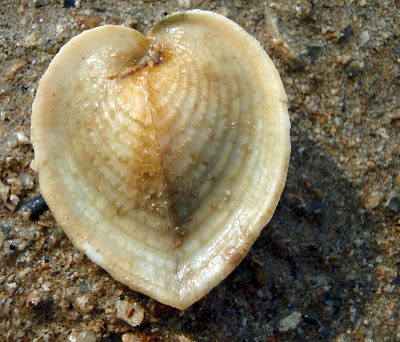After a month plus of not stepping on the 'rubbish-island' aka Semakau Land fill, we were back. Don't misunderstand, although it's a land-fill island, you won't see or smell the stench of rubbish there, click here to read more about the island.
Well, yesterday, a batch of us didn't had to guide but assigned to the role of hunter seekers, which means we need to find all the interesting stuffs, get time to photograph them and also the tag of 'If you don't see anything interesting today, blame them." =P
Question:
Why didn't we had to guide (Not all of us had the luxury, Luan Keng and Robert had to guide)?
Answer:
HSBC Green Volunteers was conducting a walk for their own staff and clients. So they took up the role of guides.
Here's the refreshed Luan Keng (picture below), who had just returned from the heights of Yunnan, busy at work...
 After reaching Semakau, 'running' through the forest trail (especially for me, since i attract the most mosquitoes) and reaching the inter-tidal area, we found that we were ahem... too early... we couldn't even see the seagrass trail which leads us further out... so we decided to walk around and exlore the area.
After reaching Semakau, 'running' through the forest trail (especially for me, since i attract the most mosquitoes) and reaching the inter-tidal area, we found that we were ahem... too early... we couldn't even see the seagrass trail which leads us further out... so we decided to walk around and exlore the area.Here's the first 'discovery', a spiral melongena (picture below)
 Discovery Note:
Discovery Note:1. This is a 'pole-vaulter' like the conches, which means they vault from place to place.
2. This is not a conch but is related.
3. The Spiral Melongena preys on barnacles.
As the tide receded, we moved further out and found 2 noble volutes laying eggs, here's one of them (picture below), second 'discovery' and my second time seeing this!
 Discovery Note:
Discovery Note:1. Volutes are carnivorous.
2. They prey on bivalves, enveloping the victim completely with their foot forcing the bivalve to finally open from exhaustion and lack of oxygen.
3. They can grow to more than 20cm and used to be common but now threaten due to 'harvesting' from humans and habitat lost.
Third 'discovery' was a heart cockle spotted by Samson.
 Discovery Note:
Discovery Note:1. The cockle lives in sand and mud in shallow water.
2. All cockles are hermaphroditic, which means they possess both the male and female sex organs.
3. Show your love by not taking them away from their homes as they are a rare find on our shores. =)
The iconic stars of Semakau, the knobbly seastars (picture below) is the fourth 'discovery', one found by Ed and one by me.
 Discovery Note:
Discovery Note:1. They get their name from the knobs they have.
2. Although most of them are mostly red or orange in colour, beige or brown coloured knobbly sea stars have been spotted before also.
3. Can you believe that a knobbly seastar might be larger than your face? It’s about 30cm across! (look at the picture below to get an idea)
 As this was an evening walk, we could find crabs out in numbers , here's one swimming crab with a beautiful carapace (picture below), fifth 'discovery'.
As this was an evening walk, we could find crabs out in numbers , here's one swimming crab with a beautiful carapace (picture below), fifth 'discovery'. Discovery Note:
Discovery Note:1. They have paddle-like swimming legs which can rotate like boat propellers to enable them to swim rapidly.
2. They usually swim sideways, but they can also swim backwards and forwards!
3. They possess long pincers armed with sharp spikes to snatch fishes and other fast-moving prey.
Whose eyes are these?
 Oh, the spider conch, sixth 'discovery'!
Oh, the spider conch, sixth 'discovery'! Discovery Note:
Discovery Note:1. This beautiful large shell is considered vulnerable due to habitat degradation and over-collection for food and as ornaments.
2. Like its relative the Gong-gong, it "pole-vaults" to move around.
3. Being rather speedy for a snail, it has large eyes to see where it is going (notice its eyes on its underside).
4. The flared shell helps to keep it from flipping over as it "hops" along.
Seventh 'discovery' are two nudibranches, the photo below shows a Gymnodoris rubropapulosa.
 And this below is a Chromodoris Nudibranch.
And this below is a Chromodoris Nudibranch.  Discovery Note:
Discovery Note:1. 'Nudibranch' means 'naked gills'. The name comes from the flower-like gills found on the back of many nudibranchs. These nudibranchs use the gills to breathe.
2. Nudibranchs are related to snails. Little baby nudibranchs are born with shells, but they lose them when they become adults.
3. Most nudibranchs are carnivores, they eat immobile or small, slow-moving prey. Examples are sponges, ascidians, hard corals, soft corals, sea anemones etc.
Besides having a great site for inter-tidal walks, Semakau is also a place to enjoy great sunsets. Here are some shots of it (pictures below)


 As the sun disappeared below the horizon, we left the inter-tidal area and head for home.
As the sun disappeared below the horizon, we left the inter-tidal area and head for home.Thank you for a wonderful sight and See you again (very soon), Semakau~
Thanks also to everyone for making this trip another photo crazy trip.. =)
No comments:
Post a Comment